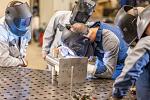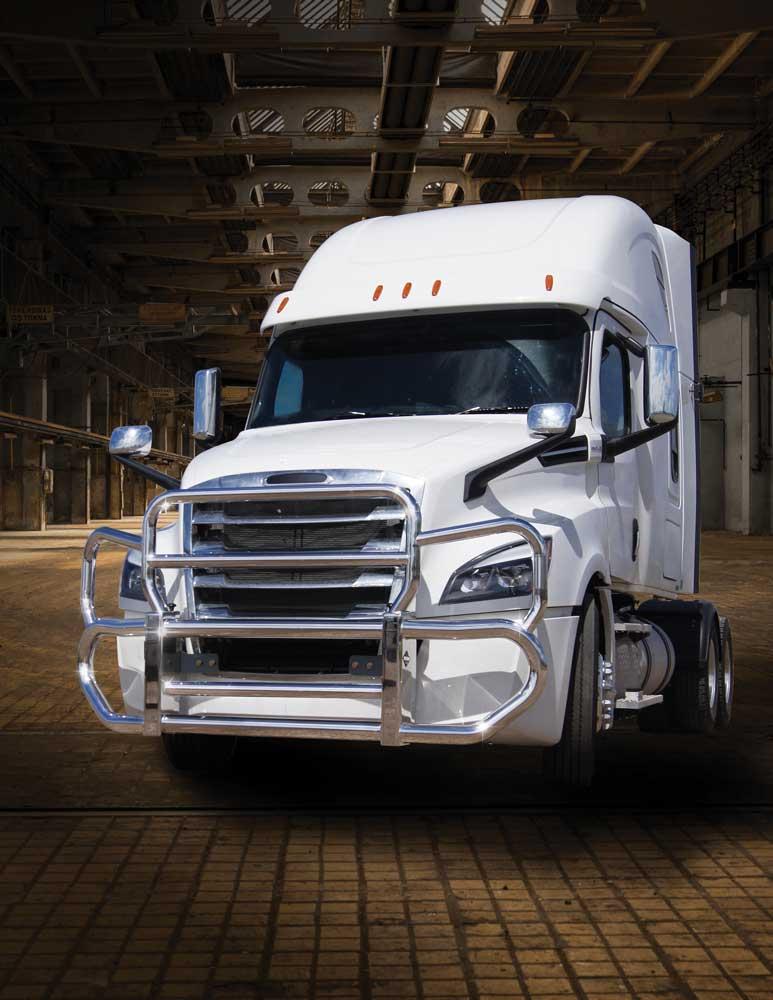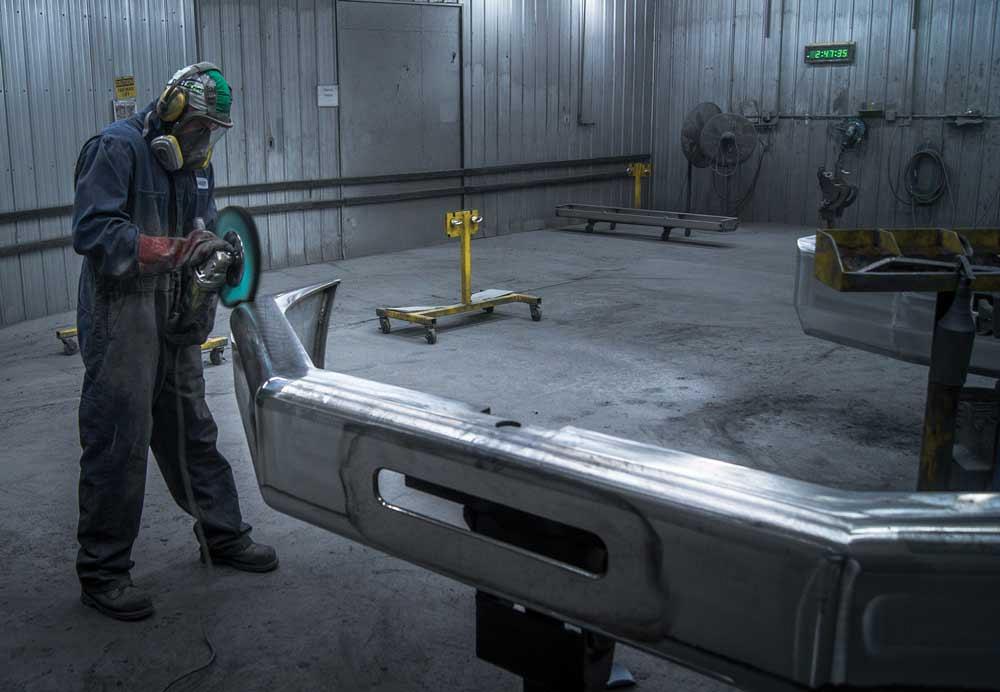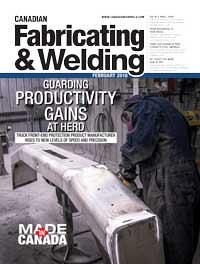- FMA
- The Fabricator
- FABTECH
- Canadian Metalworking
Guarding productivity gains at HERD
Truck front-end protection product manufacturer rises to new levels of speed and precision
- By Treena Hein
- February 20, 2018
- Article
- Fabricating
“Woodworking, but with aluminum.” That’s how Director of Operations Dave Gata described the process of manufacturing transport truck front-end protection products at his company, Winnipeg-based HERD.
“When visitors who understand metal fabrication see what we accomplish with grinders, saws, and routers, they are often in awe,” Gata said. “The way we’ve manufactured truck guards up to this point results in them all looking very similar, but every one of them was cut and bent by hand, a millimeter different here and there, making them all unique, like a fingerprint.”
However, with the precision HERD employees are now achieving with the company’s newest pieces of equipment, manufacturing is becoming much more consistent, in addition to being easier on them and much, much faster.
Stylish Protection
HERD was founded in 2003 when Marc Daudet realized there was a need for protection products for transport trucks in North America. He decided to pursue the idea, and connected his startup team with a company in Australia to learn the basics (see "The Need For Protection" at the end of the article). After trying various designs and manufacturing methods, the HERD team created and launched several product lines, custom-fit and ready to install on all major truck brands. While HERD’s transport truck guards (which replace the factory bumper and also protect the grille) prevent damage in collisions with big North American mammals such as deer and moose, they also provide stylish protection from countless incidental bumps and scrapes that happen all the time on the road.
Within its first year of operation, HERD had exported its first shipment across the border, and now sells products across both Canada and the U.S. HERD currently has about 100 employees.
HERD Basics: Extruded Aluminum Manufacturing
In the past all HERD products were made using extruded aluminum, and it is still what the company uses to make all truck guards except its new AeroPLUS product line. Here are the main steps in the labour-intensive process to make fully integrated guards:
- Three components are involved in each product: uprights, bumper, and tubes.
- To make uprights, C-channel pieces (cut to size and shape) are welded, sanded, and polished.
- The bumper sections are manually formed from extrusions, and then angles and holes are cut to allow airflow and eventually signal light installation (during final product mounting). Then the section is gas metal arc welded, which again involves a lot of angle measuring. Finally, hinges are added.
- Tubes arrive as extruded pieces that are then cut and bent to size to provide the best fit and finish for each truck brand.
- During assembly, uprights, bumpers, and tubes are tacked and then GMAW welded, polished, and buffed.
- To achieve a chrome-like mirror finish, the company uses a proprietary set of finishing steps involving various techniques, polishes, and tools – consuming more than 1.3 million sheets of sandpaper per year.
In the final step, hinges are tested and various pieces of hardware and components are added.
New Product Lines, New Equipment Needs

During assembly, uprights, bumpers, and tubes are tacked and then gas metal arc welded, polished, and buffed.
Planning began in 2015 to produce a new truck guard line, a lighter and stronger product that would provide customers with better fuel efficiency and be easier to operate.
Gata explained that from the very moment they began mapping out the process to make the AeroPLUS, they knew a CNC press brake was a necessity. The cost of outsourcing the cutting and bending of flat aluminum sheets would be too high, but he also recalled, “We knew that being able to use laser-cut pieces on our own equipment would give us endless possibilities for forming products to specific brands of truck. Flats give us total flexibility.”
The Accurpress press brake (installed in October 2017) and Horn CNC tube bender (installed in April 2017) are also being used to fabricate the company’s new Grill Guard line from stainless steel. “Our engineers have certainly been on a learning curve with it,” Gata said, “but in terms of operation, we’ve been full-bore out of the gate because we were able to recruit an operator with 20 years’ experience. He’s currently training a keen junior operator and an assistant. Our bender is allowing us to produce between 10 and 12 Grill Guards in an eight-hour shift.”
The new bender also was needed because the top and bottom stainless steel tube parts of the Grill Guard have a gauge thickness of 14 to 16 and a diameter of 3.5 in. “There’s only one external vendor in Manitoba that can bend that diameter,” Gata said, “so we absolutely needed to have our own machine. The one we chose can actually handle 4-in.-diameter steel, so we have extra capacity.”
Having the bender also slashes prototyping time.
“We used to rely on our vendor, but now our designer knows just what our bender is capable of, and that means so much speed is added to everything in the process,” said Gata. “We can produce a prototype in one day as opposed to waiting for the vender to fit us in, which could mean two to four weeks. So while it’s hard to gauge ROI on this machine, just being able to massively decrease prototype time has been invaluable. When we have a design program finished, we’re good to go.”
Safety Benefits
Having these new pieces of equipment is also making work easier for employees, trimming the need for heavy lifting and tasks like hacking away pieces with a saw.
“Employees who were previously doing what would be considered general labour are now operating these machines,” Gata explained. “There is more pride and fulfillment. It’s only been a short while since we got the press, but we are seeing great progress already. Some employees viewed the new equipment as something that would replace them, but they are becoming more and more convinced that working with this equipment will help them be more precise and with less physical impact.” With the boost in fabrication speed early in the process, more labour is being hired for downstream finishing.
If you’re wondering if extruded aluminum will continue to be used at HERD in the long run, the answer is no. Gata said that until they have completely phased out aluminum extrusions, they will continue to adjust processes to achieve more efficiency and do more bending in-house. “I’d really like a second press brake, and there have been some discussions about getting a laser cutter, but we’ll have to see how that plays out,” he said. “Adding one would also require changes in the plant layout.”

The Accurpress press brake (installed in October) is being used to fabricate the company's new AeroPlus line in aluminum, as well as its Grill Guard line in stainless steel.
The HERD team spent the latter part of 2017 making a suite of AeroPLUS and Grill Guards SKUs for various brands preferred by fleets, prepping for full launches of these lines in early 2018.
Treena Hein is an Ottawa-based freelance writer.
Photos courtesy of HERD North America, www.herd.com
The need for protection
In Australia, transport truck guards (commonly called “roo bars” there), used to protect them in collisions with kangaroos and more, have been around for quite a while. They’re used on regular transport trucks and also on “road train” trucks, the trucks that drive across the Outback from one side of Australia to the other, pulling three, four, five, or even six 48-foot-long trailers behind them.
While hitting kangaroos is most common, vehicles also collide with deer, wombats, cows, and more, and researchers have concluded that vehicles are likely to receive damage if not protected. Here in Canada, the Wildlife Collision Prevention Program in British Columbia reports that every hour across the country, four to eight vehicles collide with large animals, and the Insurance Corporation of British Columbia stated in 2017 that roughly 10,000 animal-related collisions occur every year in that province alone.
HERD Accomplishments
• To help the trucking industry deal with the worsening driver shortage, HERD engineered Lift Assist, a spring system that reduces the weight of the company’s truck guard products by up to 75 per cent. Lift weight becomes as little as 13 to 15 pounds. Watch the video at www.HERD.com/options.
• HERD has grown its U.S. exports and plans to continue export growth. It received the Emerging Manufacturer Award from Canadian Manufacturers & Exporters in 2013.
About the Author
subscribe now


Keep up to date with the latest news, events, and technology for all things metal from our pair of monthly magazines written specifically for Canadian manufacturers!
Start Your Free Subscription- Trending Articles
Class is in session for college connections

BlueForge Alliance partners with Nuts, Bolts & Thingamajigs to develop Submarine Manufacturing Camps

Engine-driven welding machines include integrated air compressors

Orbital tube welding webinar to be held April 23

Portable system becomes hot tech in heat treatment

- Industry Events
ZEISS Quality Innovation Days 2024
- April 15 - 19, 2024
Tube 2024
- April 15 - 19, 2024
- Düsseldorf, Germany
CTMA Economic Uncertainty: Helping You Navigate Windsor Seminar
- April 30, 2024
- Windsor, ON Canada
MME Winnipeg
- April 30, 2024
- Winnipeg, ON Canada
CTMA Economic Uncertainty: Helping You Navigate Kitchener Seminar
- May 2, 2024
- Kitchener, ON Canada

















